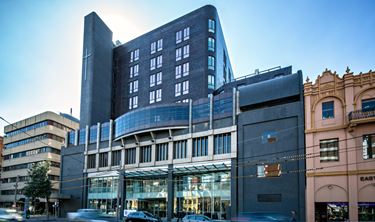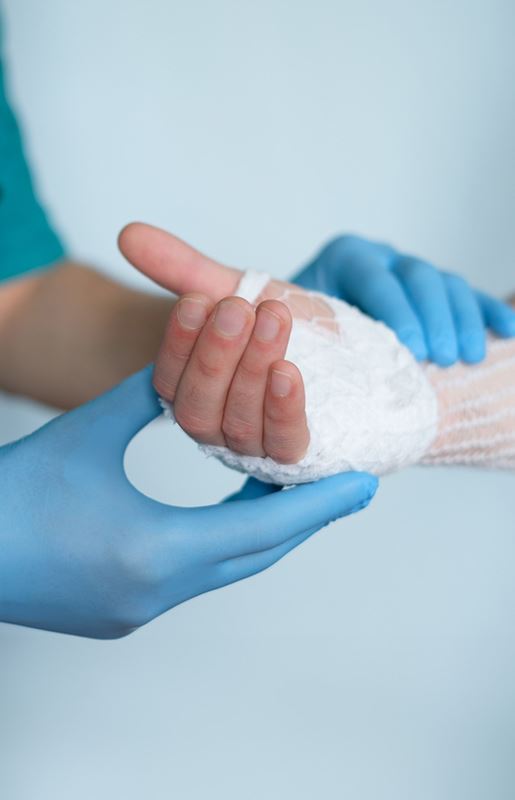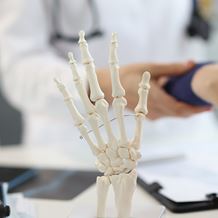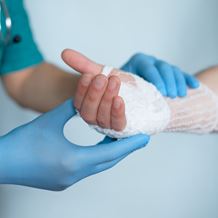Dupuytren’s Contracture Surgery
- Home
- Services
- Orthopaedics
- Hand Orthopaedics
- Dupuytren’s Contracture Surgery
What is Dupuytren’s Contracture surgery?
Dupuytren’s Contracture surgery is a medical procedure to correct advanced cases of Dupuytren’s Contracture , sometimes known as Dupuytren’s disease. This common hand condition starts when the layer of tissue under the palm of the hand (palmar fascia) starts to thicken and form Dupuytren nodules. Over time, the tissue continues to tighten, and the fingers start to pull in towards the palm of the hand. This means that simple daily tasks can become increasingly difficult to achieve.
If non-invasive treatments are not successful, your doctor may recommend Dupuytren’s Contracture surgery to relieve the tension and disfigurement caused by Dupuytren’s disease. The surgery works by either dividing the thickened cord beneath the skin, or by removing it altogether to allow the fingers to straighten. In some cases, a skin graft may be needed to close the palm. After surgery, a splint may be worn to reposition the fingers, and special hand exercises will be prescribed to encourage flexibility.
Is it right for me?
Dupuytren’s Contracture is not a serious disease, but the symptoms can become painful and unsightly over time. As the fingers curl over towards the palm, it can make usual gestures difficult like shaking hands or slipping your hand into your pocket. There are various non-surgical treatment options available which focus on breaking apart the cords of tissue that are causing these symptoms:
- Anti-inflammatories – to slow the progression.
- Needling – to puncture and break up the contracture.
- Collagenase injection – to weaken and break up the cords of tissue.
If your symptoms are slow to progress, they may be able to be controlled non-surgically for many years. However, if you begin to have difficulty using your hand for certain tasks like gripping, or straightening your fingers becomes difficult, talk to your doctor about how Dupuytren’s Contracture surgery may benefit your condition. Although there is no cure, Dupuytren’s Contracture surgery can significantly slow the disease and relieve uncomfortable symptoms.

Other hand surgeries and procedures
Common hand conditions
Dupuytren’s Contracture Surgery - Patient Journey
Dupuytren’s Contracture surgery is a successful medical procedure to treat Dupuytren’s disease and relieve the common symptoms associated with the condition. There are different types of surgery available, and your doctor will discuss the recommended course of action for your condition. We understand that any kind of medical procedure can be overwhelming, which is why we have multi-disciplinary teams on hand to support you at every stage. We are dedicated to providing a safe and comfortable patient experience at all times.
Deciding where to have your Dupuytren’s Contracture surgery is extremely important, and you should take some time to research your options carefully. Ask your doctor for some recommendations and use the opportunity to find out any relevant information such as the type of surgery recommended, and the benefits and risks associated with the procedure. Look for hospitals that have expertise and experience in treating Dupuytren’s Contracture. Once you are happy with your decision, you can book a consultation appointment with your chosen specialist.
Your specialist will conduct a thorough medical examination and gather information about your general health. The extent of the Dupuytren’s Contracture symptoms can be fully assessed, and surgery may be recommended to order to reduce the contracture, improve flexibility in the fingers and slow the onset of the disease. Your consultation can also be used to answer any questions you may have, such as what procedure will be performed, whether you require minimally invasive or open surgery, and what you can expect your recovery to look like. You can also discuss the benefits of Dupuytren’s fasciectomy, the types of fasciectomies available, and what might happen without surgery. Once your doctor has advised on a course of treatment, you can begin to prepare for your hospital admission and surgery.
Your doctor will talk to you about what you need to do to prepare for Dupuytren’s Contracture surgery. This may include taking or stopping any prescribed medications such as blood thinners. It’s important to prepare for your discharge such as organising transport home after the operation. As your hand will be bandaged or in a splint after surgery, you may want some help at home with meal preparation and daily tasks until you are feeling better. When you arrive at hospital, our team will make sure you are comfortable, and your hand orthopaedic specialist will visit you to answer any final questions.
On the day of your Dupuytren’s Contracture surgery, it is important to follow your surgeon’s fasting advice to prevent any delays to your procedure. Once at hospital, your anaesthetist will talk to you about the type of anaesthetic to be used and the procedure involved. Dupuytren’s Contracture surgery can be performed in different ways depending on the extent of the condition, and your surgeon will talk to you about what will happen during the procedure. The operation itself can take between 30 minutes - 2 hours, and in less severe cases patients are usually discharged the same day.
There will be some pain, swelling and stiffness after Dupuytren’s Contracture surgery, and your hand is likely to be bandaged or in a splint to help with your recovery. Keeping your hand above your heart will help reduce the swelling. In milder cases of Dupuytren’s disease, patients will be discharged the same day along with a personalised rehabilitation program, wound care information and medication to help with the pain. The full recovery time is different for all patients and will depend on the extent of the surgery, but it is likely to take up to 12 weeks.
The rehabilitation program after Dupuytren’s Contracture surgery will vary by patient as the type of procedure will depend on the severity of the condition. Hand physiotherapy is an important part of your recovery journey after your operation as it improves the function and range of movement as the hand heals. It also helps to minimise scar tissue. The incisions may take a couple of weeks to heal, and during this time it is better to keep your hand rested. Most patients regain finger motion within 4-6 weeks, although a full recovery could take up to 12 weeks.
Dupuytren’s Contracture Surgery FAQs
- Fasciotomy: The fibrous bands are divided using a fine needle or sharp blade, releasing the tightness that causes the contracture and allowing your fingers to straighten once more.
- Dupuytren’s fasciectomy: Part or all the affected tissue is removed to allow the fingers to stretch out. This can be achieved in different ways depending on the severity of the condition.
- Partial fasciectomy – Only a segment of the affected tissue is removed.
- Subtotal fasciectomy – All the diseased tissue is removed, possibly requiring a skin graft to heal.
- Dermo fasciectomy – All the diseased tissue is removed along with some skin from your palm, also requiring a skin graft to heal.
- Lumps or nodules in the palm of your hand that may feel painful
- Thickened cords of tissue under the skin
- Finger contracture that worsens as the tissue tightens
- Lack of hand flexibility
Contact us today for a specialist consultation and to learn more about how you could benefit from Dupuytren’s Contracture surgery.
Find a hospital with orthopaedic services
Our Hospitals




